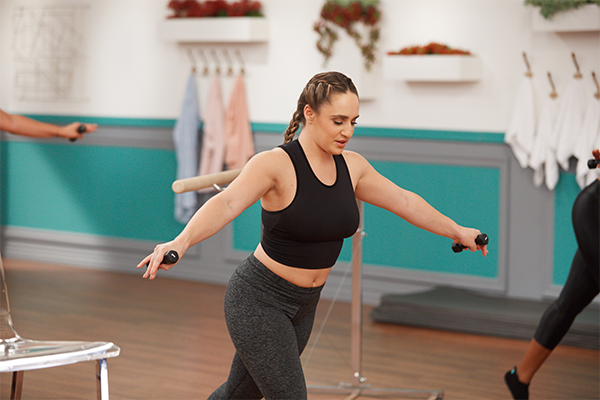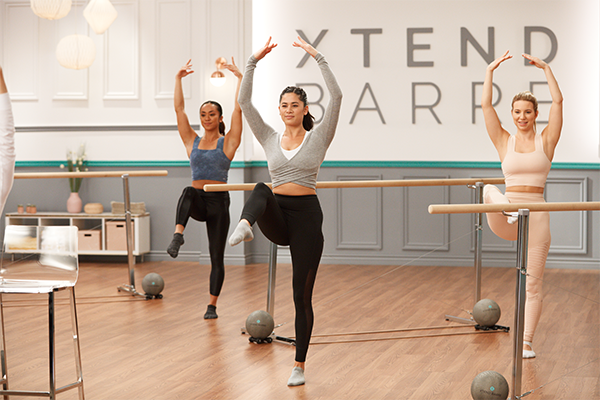6 Barre Form Mistakes You’re Probably Making

By now you’ve likely heard all about the benefits of barre workouts, with their slow, controlled movements designed to make your muscles shake and burn.
Inspired by ballet and Pilates, these classes can help tone and strengthen your entire body — especially your core and booty.
But, in order to reap the full benefits of your routine, you want to make sure you’re doing all your barre moves correctly.
That starts by choosing a barre workout that focuses on keeping you healthy as you build strength and burn calories.
“Xtend Barre is a form-focused program that utilizes controlled, precise movements,” says Andrea Rogers, creator of the Xtend Barre workout on Beachbody.
“No other workout combines grace and athleticism like Xtend Barre. By combining traditional Pilates methods with ballet and high-energy cardio, the workout is designed to sculpt bodies into lean, toned, ‘dancer-like’ physiques,” says Rogers.
“Not only will you see physical results, but you will also gain a strong understanding of how to move with good technique and form, which results in increased body awareness and confidence.”
Why Is Proper Form So Important?

In barre, as with any workout, proper form is paramount, says Rogers.
While Xtend Barre is appropriate for all levels, those who are new to the practice should train their focus on the fundamentals, which helps prevent injuries, teaches you to activate the right muscles, and heightens body awareness.
“With proper form, you’re going to prevent straining or pulling muscles, causing injury,” explains Rogers.
“And it also enables you to activate the muscles effectively, getting more ‘bang for your buck’ out of each rep.”
And, emphasizing proper form with all barre exercises is what truly creates that aforementioned “dancer’s physique.”
“Creating body awareness at the barre will condition you to carry this with you throughout your everyday life, creating better posture and a healthy body,” explains Rogers.
Her cues throughout the Xtend Barre workouts will remind you to keep your shoulders back and down, your core engaged, and your chest up.
The 6 Most Common Barre Form Mistakes
Rogers is a classically trained Pilates instructor and former professional dancer, so it’s no surprise that she’s quick to spot form mistakes that can cause problems.
The chief mistake newbies make?
Exaggerating moves to look like a dancer: going too low in pliés/squats, turning their feet out too far, or stretching too deep.
“Dancers have been doing those movements for years,” says Rogers. “We encourage our students to use their natural range of motion.”
Your flexibility and range of motion will increase with time!
Here, Rogers breaks down the six most common barre form mistakes you’re probably making (don’t worry — you’re not the only one!), and offers her expert advice on how to correct them.
1. You’re not breathing

In barre, your breathing is not as regimented as it is in Pilates or yoga, but your breath does matter, says Rogers.
“At Xtend, we focus on not holding your breath to ‘get through’ an exercise,” she explains. This can increase the risk of injury and weaken the effectiveness of barre moves.
You will sweat during Xtend Barre (it combines strength and cardio, for weight loss and toning), so holding your breath will feel very uncomfortable.
How to fix it: “Use your breath as a tool to help further engage your muscles and deepen your potential,” says Rogers.
Listen to her cues throughout your workouts, and you’ll start to pick up on habits like exhaling through the hardest part of your abs moves or to go deeper into a stretch.
2. You’re tucking your tailbone all the time
The barre “tuck” is common in some classes — but not in Xtend Barre.
The tuck is really a posterior tilt of the pelvis and lower back, so when you add a butt squeeze it compresses your lower back, setting you up for injury.
“We work within a neutral spine position to maintain a strong and healthy spine,” says Rogers.
The barre tuck should be reserved for very few exercises, she says, and your abs should always be contracted to keep your back safe.
How to fix it: Don’t stick out your booty or tuck your tailbone under — keep your hips centered over your feet.
“Imagine working between two window panes to keep your spine neutral,” says Rogers.
3. You’re not keeping your core engaged

Rogers talks about the core a lot in each Xtend Barre workout — for good reason.
“Every movement is initiated by the core,” she says. “We start from the inside out — if you’re not engaging your core, you’ll likely feel unbalanced and struggle with coordination and execution of a move.”
Barre also helps build a healthy back and strong pelvic floor, which are part of your core.
How to fix it: It’s not about sucking in. It’s about finding strength in your core, especially the transverse abdominis — those deepest core muscles, says Rogers.
“Take time to break down how to properly engage your core by focusing on lifting your abs in and up. Imagine your core is a corset and you are tying the strings tighter.”
4. You’re using the wrong weights (or no weights)
Xtend Barre uses light weights to increase total-body strength. Beginners sometimes skip them — or overdo it.
“If you’re not using the weights, you’re not strengthening and sculpting as much as you could be,” says Rogers.
But reach for weights that are too heavy and you may feel strain in your neck and shoulders.
How to fix it: Rogers recommends sticking with 1- to 3-pound weights. If you don’t have any lying around, grab household objects like water bottles or canned food.
“The goal is to encourage your muscles to resist gravity,” she says.
5. You’re skipping the cooldown stretches

If you’re not doing the cooldown stretches, you’re missing out on some of the best barre moves.
Rogers calls the cooldown your reward for making it through all those reps.
“I believe in stretching,” she says. “Your body needs to move through its full range of motion.”
And, at the end of your workout, when your body is warm and your muscles are exhausted, stretching just feels good.
How to fix it: Hang in there until the end!
“The cooldown is also a mental game that allows you to decompress and focus on your body as a whole,” Rogers explains, adding that it’s a time to reflect on all you’ve accomplished and how far you’ve come.
6. You’re using momentum, not your muscles
Barre exercises are all about control, so don’t be tempted to rush through them.
“You’ll use momentum to help you move, which can cause injury,” cautions Rogers. “Over time, you start to understand how to not use the weaker areas to compensate for the movements.”
How to fix it: Slow down, breathe, and remember: “Momentum is not a muscle.” (That’s one of Rogers’ favorite cues.)
“We constantly cue core initiation and neutral spine,” she says, which reminds you to stay strong from the inside out — so momentum can’t take over.
